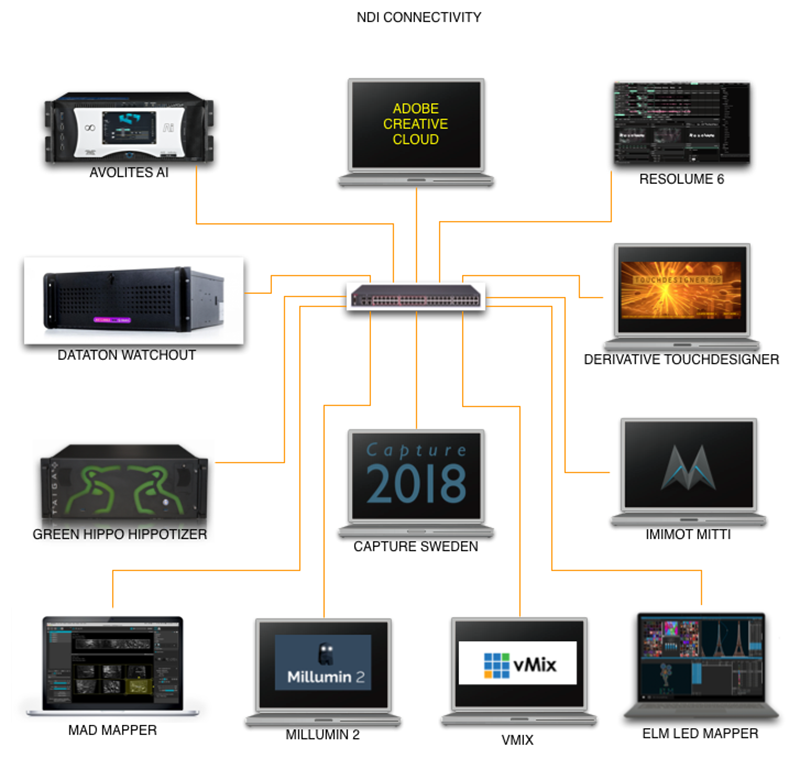At Prolight+Sound 2018, I found myself engaged in several discussions about the need for a way to take the output from a media server and input it into a previsualization environment. While there are already a handful of options for sharing video between media servers, lighting consoles, video playback devices, and/or visualizers currently in use (CITP, Syphon, and Spout, to name a few), these are somewhat limited solutions. Issues like low image resolutions and/or low frame rates during playback have made them useful only in some applications.
This topic, as I’m sure you can imagine, inspires a wide variety of opinions. This is due in part to the fact that, while there are a few options available for Video Over IP currently, the video industry as a whole has not yet adopted a common standard approach. So, what is the solution to this need? I decided to do a little research and see if I could form my own opinion.
To begin, I needed to understand a little more about Video Over IP as whole, including all the challenges it has to address:
Encapsulating Video Data: Encoding and decoding the video data and doing so in such a way that the data is transferred intact and with as little delay as possible.
Dealing with Packet Loss: Packets of video data can’t arrive late!
Protection of Data During Transfer: How do you ensure content is secure as it’s being transmitted?
Bandwidth: Creating a network for video data has to include adequate bandwidth while ideally using the least amount of compression necessary to deliver the packets of data in the quickest way possible.
One of the first Video Over IP solutions was SMPTE 2022-6, which was introduced in 2015. At that time, SMPTE 2022-6 looked promising, but as 4K content arrived on the scene, SMPTE 2022-6 was quickly pushed to its limits and “struggled to handle 4K/UHD raw uncompressed video easily”1 despite using a 10 Gigabit network. As a result, new codecs for SMPTE 2022-6 were developed, including TICO; these types of codecs allow SMPTE 2022-6 to support 4K/UHD by compressing it “enough to get it down the pipe.”1 Some of these require royalty fees, however, likely making them not as desirable to the majority of video device manufacturers and software developers.

NDI
At IBC 2015, NewTek introduced its own IP-based protocol called NDI, making it possible for an NDI capable device connected to other NDI devices on a network to be able to share data. And they have wisely made NDI available to any developer who wants to use it without requiring royalty fees, ensuring its appeal across a broad range of products. In fact, several of the most popular media servers and lighting visualizers used in live entertainment applications today have added NDI support, including Watchout5, Ai6, Hippotizer v4.37, resolume v68, and Capture9. And with many more media servers beta testing NDI support as well, it’s looking promising that NDI might just be the Video Over IP solution that opens the door widely to sharing video over a network between lighting consoles, media servers, and previsualization applications in our industry.
So how does NDI stack up with regards to the four main areas of evaluation in this article? Let’s take a look:
- Encapsulating Video Data: NDI uses its proprietary NDI codec for compression, which allows transfer of video data over a 1 Gigabit network (as opposed to a 10 Gigabit network that is required by the SMPTE 2022-6 standard).2
- Dealing with Packet Loss: Newtek touts NDI as the “first ever codec to provide multi-generational stability; this means that once a video signal is compressed, there is no further loss.”3
- Protection of Data During Transfer: Since NDI requires an encoder and decoder, it would difficult to intercept data without NDI compatible gear.
- Bandwidth: As stated on the Newtek website: on an independent 1 Gigabit network, multiple ~100 Mbps streams are possible.” 2
In the technical brief labeled “newtek-ndi-technical-brief,”3 I found a comparison table for “expected bandwidth loads in common delivery formats.” Here is the info:
- 1 stream of SD video=20Mbps
- 1 stream of 720p50/59.94 video=90Mbps
- 1 stream of 1080i50/59.94 video=100Mbps
- 1 stream of 1080p50/59.94 video=125Mbps
- 1 stream of UHDp30 video=200Mbps
- 1 stream of UHDp60 video=250Mbps
A few other features of note about NDI:
- It is a bi-directional protocol that supports multiple streams of video simultaneously4;
- It can support all resolutions, frame rates, and video streams, with or without alpha channel including 4K+
content; - It supports up to 16 channels of audio;
- It is designed to work with standard consumer grade networking devices.
Using a Video Over IP protocol like NDI appears to be the direction our industry is heading for many reasons. For one, it simplifies and streamlines the process for sharing video content between various devices without the need of using SDI, HDMI, video capture cards, etc. This, in turn, helps with the overall system design including weight, costs, etc. Another huge advantage for a Video Over IP protocol like NDI is that it opens up the door to a world of interconnectivity between professional grade video and lighting products. And, while it does have some challenges (creating, configuring, and maintaining the network, for instance), the pros far outweigh the cons for moving in this direction (remote content upload, control and access being just some of them). Thus, the time is right for a solution that can capitalize on fast networking connectivity while delivering the HD resolution we expect; and I think NDI might just be the right one.
Sources for this article:


